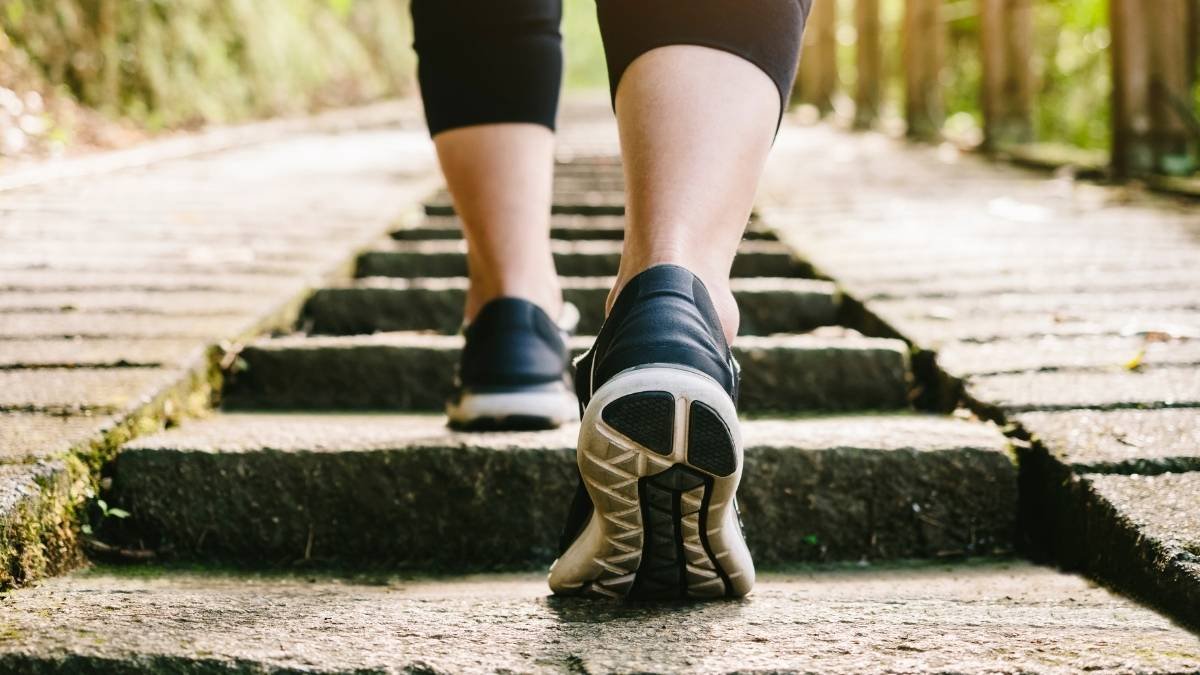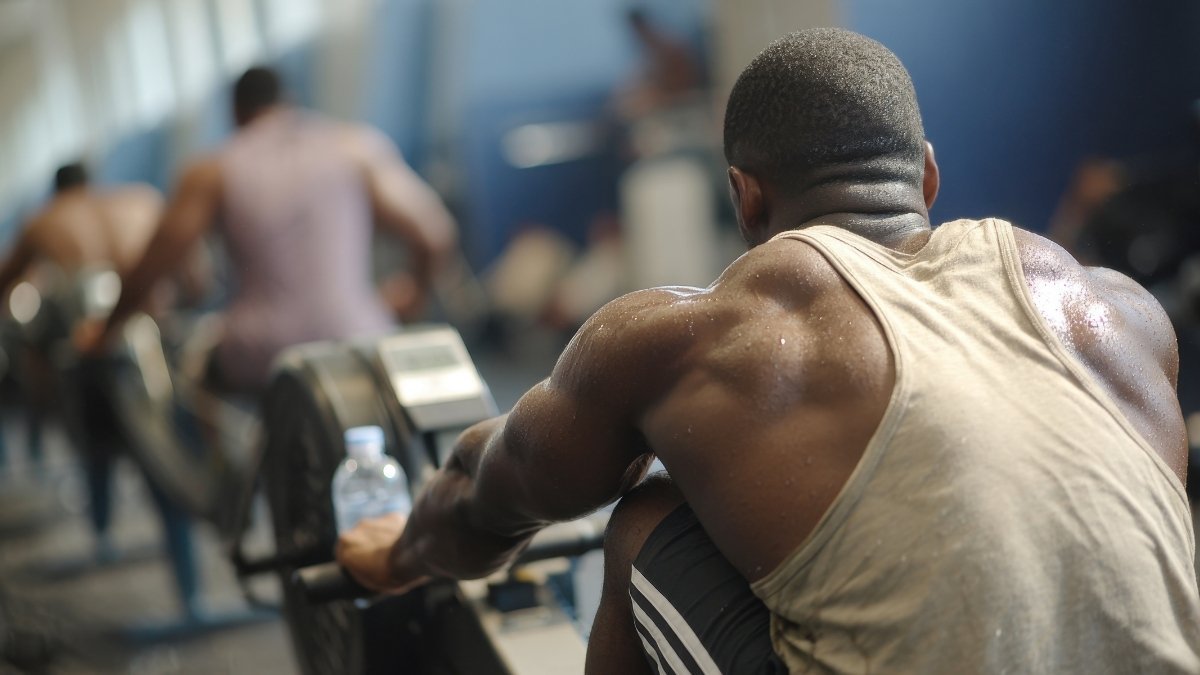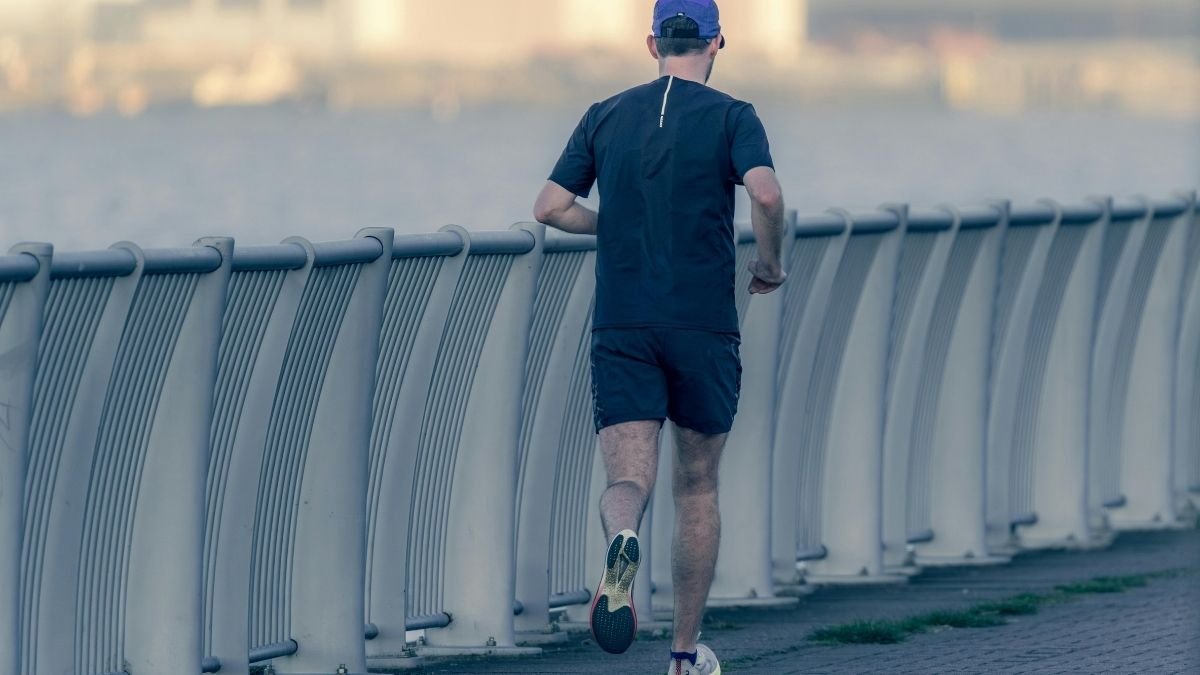
Let’s be honest. You know that feeling. It’s 9 p.m., you’re finally on the couch, and your fitness tracker buzzes with that smug little notification: “You’re 4,800 steps short of your 10,000-step goal.”
Ugh. It feels like a failure. Another day, you didn’t measure up.
For decades, we’ve had this “magic number” drilled into our heads. 10,000 steps. It’s the default on every app, the gold standard for health, the pass/fail grade for being an “active” person.
But what if I told you that number is… well, basically, it’s a lie.
Or, to be fairer, it’s a marketing slogan from the 1960s that we all just sort of… accepted as medical fact.
The 10,000-Step Lie: A 1960s Marketing Trick

Seriously. The 10,000-step goal wasn’t born from a massive, global health study. It came from Japan in 1964, right around the Tokyo Olympics. A company called Yamasa wanted to sell a new device, a pedometer, and they needed a catchy name for it.
They called it the “manpo-kei”.
This literally translates to “10,000-step meter”. Why 10,000? Not because of science. It was because the number was “catchy”, “easy to remember”, and the Japanese character for 10,000 (万) looks a bit like a person walking.
That’s it. It was a 1960s ad campaign.
The problem is, this arbitrary number is stuck. It became so popular that health organizations like the World Health Organization (WHO) and the American Heart Foundation (AHA) eventually adopted it because, hey, it got people moving. But it was never the real scientifically-backed minimum.
And as Dr. Robert Fineberg, a physician and obesity medicine specialist, points out, this all-or-nothing number “can discourage people if the number feels out of reach”. It creates exactly that feeling of failure we all know too well.
What Your Doctor Actually Recommends (It’s Not a Step Count)

So, if 10,000 is just a slogan, what’s the real goal?
When you ask major medical bodies like the U.S. Centers for Disease Control and Prevention (CDC) or the AHA, they don’t actually give you a step count. Their official, evidence-based gold standard is all about time and intensity.
Here it is:
- 150 minutes of moderate-intensity physical activity per week.
- AND 2 days of muscle-strengthening activity per week.
That 150-minute rule is the key. Why? Because it’s so much more flexible and inclusive. Think about it: a 30-minute bike ride, 45 minutes of gardening, or a water aerobics class might not rack up a ton of “steps,” but they absolutely count toward that 150-minute goal.
The official motto is simple: “Move more, sit less”. Any activity is better than no activity.
In Simple Terms: What Is “Moderate-Intensity”?

This sounds vague, I know. But there’s a really simple way to measure it called the “talk test”.
You’re in the moderate-intensity zone when: “your heart will beat faster and you’ll breathe harder than normal, but you’ll still be able to talk”.
Can you sing your favorite song? You’re going too light. If you can’t get a sentence out without gasping? You’re in the vigorous zone (which is also great, you just need less of it—75 minutes a week).
Brisk walking (at least 2.5 mph), dancing, and even heavy-duty gardening all count.
The New “Magic Numbers”: The Real Minimums for Your Body and Brain

Okay, but let’s be real. We like counting steps. It’s simple, our phones do it automatically, and it’s a concrete number.
Here’s the great news: In the last few years, scientists have finally crunched the numbers to figure out what the real, evidence-based step goals are. And every single one of them is way, way lower than 10,000.
The 2,400-Step “Heart” Minimum

Let’s start with the absolute minimum. A massive 2023 meta-analysis (that’s a study of 17 other studies, covering 226,889 people) found that the benefits for your heart—specifically, reducing the risk of dying from cardiovascular disease—start at just 2,337 steps per day.
That’s not a typo. The study also found that for every extra 500 steps you take, you lower your risk of cardiovascular death by another 7%.
The 3,000-Step “Brain” Minimum

This one is incredible. A major 2024/2025 study from Mass General Brigham looked at walking and cognitive health in older adults at risk for Alzheimer’s.
What they found is staggering:
- Walking 3,000 to 5,000 steps per day was linked to an average 3-year delay in cognitive decline.
- Walking 5,000 to 7,500 steps per day extended that delay to an average of 7 years.
The theory is that walking helps slow the buildup of toxic tau proteins in the brain. This is a powerful, tangible benefit from a very achievable number.
The 4,000-Step “Longevity” Minimum

This is the big one: “all-cause mortality,” which is just a research term for “dying from any cause.”
That same giant 2023 analysis found the minimum threshold for seeing a progressively lower risk of all-cause mortality starts at just 3,867 steps per day (let’s just call it 4,000). Every 1,000 steps above that was linked to a 15% drop in mortality risk.
This was backed up by a landmark 2019 Harvard-led study on older women. It found that as few as 4,400 steps per day gave them a significant longevity boost compared to sedentary women.
The 7,500-Step “Sweet Spot”: Why More Isn’t Always Better

So, if 4,000 is good, is 10,000 better?
Here’s the most freeing piece of news: not necessarily.
That same Harvard study on older women discovered that the longevity benefits kept increasing until about 7,500 steps per day. After that, the benefits plateaued, or leveled off. A 2022 meta-analysis confirmed this, noting that the size of the health improvements started to slow down after 7,000 steps.
For most people, the “sweet spot”—the point of diminishing returns—is right around 7,500 to 8,000 steps.
The one big caveat: If you are highly sedentary (meaning you sit for 10.5 hours or more every day), a 2024 study found that your “optimal dose” to counteract all that sitting is in the 9,000 to 10,500-step range. So 10,000 is still a fantastic goal, it’s just not the minimum for most of us.
| The New Science-Backed Step Goals (And Where to Start) |
| Health Benefit |
| Cardiovascular Health |
| All-Cause Mortality |
| Cognitive Health (Dementia) |
| Older Adults (Mortality) |
It’s Not Just How Many—It’s How You Walk

So, we have new, better numbers. 4,000 is a great start; 7,500 is a fantastic goal.
But there’s one more layer. It turns out 5,000 steps from meandering around your house all day isn’t quite the same as 5,000 steps from two brisk, 25-minute walks.
This brings us back to that “moderate-intensity” idea. It’s not just about volume (how many), it’s about intensity (how fast) and duration (how long).
The 100-Step-Per-Minute Rule

How fast is “brisk”? Again, science has a simple answer. The “heuristic” (which is just a fancy word for “practical rule of thumb”) is 100+ steps per minute. This is the pace that consistently gets most adults into that “moderate-intensity” zone. (For older adults, it might be slightly higher, around 105 steps/min ).
A cool Copenhagen study on cycling commuters found that intensity (a faster commute) was linked to a five-year increase in life expectancy, while duration (a longer, slower commute) showed no extra benefit. The takeaway? Pace matters.
The Power of “Purposeful” Walks
This is the newest, and maybe most important, finding. A 2025 study analyzed how people got their steps. Did they get them in short, sporadic bursts (like walking to the kitchen or the bathroom)? Or did they get them in longer, “purposeful” walks?
The finding was crystal clear: taking longer walks of at least 10 to 15 minutes at a time was way better for heart health and longevity.
In the study, people who got most of their steps in tiny <5-minute bursts had a 4% chance of dying during the follow-up. For people who got their steps in 15+ minute bouts, that risk dropped to 0.8%.
Why? Experts think it’s because it takes time for your “cardiometabolic system to ‘fire up'”. A 2-minute walk doesn’t fully engage all the good stuff, like improving your insulin sensitivity.
This gives us a new, unified goal: Don’t just chase a total number. Aim for one or two 10-15 minute “purposeful” walks per day, hitting that 100 step/minute pace. That alone will get you 2,000-3,000 high-quality steps.
Your Actionable Roadmap: From Sedentary to 5,000 Steps

This is all great, but if your current average is 2,000 steps, 5,000 can still feel like a mountain. So let’s make this simple and safe.
Step 1: Find Your “Honest” Baseline (No Judgment)
Before you add anything, you need to know your starting line. A “sedentary” lifestyle is technically defined as averaging fewer than 5,000 steps per day. Many of us are even lower.
For three days, just carry your phone or wear your tracker and do nothing different. Get your average. This isn’t a grade. It’s just data.
Step 2: Set a Safe Goal (Avoid This Common Mistake)

The #1 way to fail a new walking habit is “Too Much, Too Soon”. Jumping from 2,000 to 8,000 steps is a recipe for shin splints, burnout, and quitting.
Dr. Milica McDowell, a doctor of physical therapy, says a “deconditioned” person should only add about 5% more per week (like 250 extra steps a day).
A more practical rule from the Mayo Clinic? Just add 1,000 extra steps per day. That’s it. It’s only about 10 minutes of walking. Do that for a week or two until it feels normal, then add another 1,000.
Step 3: 5 Simple Ways to Add 2,000 Steps (Without a Gym)
You don’t need a special “workout.” You just need to reframe your day.
- “Habit Stack.” This is my favorite. Attach a new 10-minute walk to a habit you already have. Example: Every day, immediately after you finish lunch, you walk for 10 minutes.
- “Walking Snacks.” Break up long sitting spells. Set an hourly timer. When it goes off, stand up and walk around your house or office for just 2-5 minutes.
- Be “Productively Inefficient.” We’re programmed to find the closest parking spot. Stop. Park in the farthest spot on purpose. Always take the stairs. Walk inside the pharmacy instead of using the drive-thru.
- Make it Social or Audio. Walk with a friend, your partner, or a dog. Or, make a rule: you only listen to your favorite podcast or audiobook while you’re walking.
- For Remote Workers: Pace your room during audio-only calls. Have a “solo dance party” in the kitchen while waiting for the kettle to boil. It all counts.
Step 4: A Quick Guide to Tracking: Watch vs. Phone

Don’t want an expensive watch? You don’t need one.
- A smartphone in your pants pocket is “very accurate” for step counting, because your hip is “really the best place for measuring steps”.
- A wrist-worn watch is also great, but can sometimes log “extraneous movement” (like talking with your hands) as steps.
- The takeaway: Your phone is a perfect, free, and accurate tool for this.
Need a Little Extra Motivation? A Few Tools That Genuinely Help
You absolutely don’t need to buy anything to start walking. Your phone in your pocket and a pair of comfy shoes is all it takes. But, let’s be real, sometimes a new gadget can be the little kick in the pants we need to get started and make the new habit stick.
Here are a few things that can make a real difference.
1. A Simple Fitness Tracker

This is the obvious one, but you don’t need a top-of-the-line, expensive model. Honestly, just seeing that number climb from 2,500 to 4,000 is a huge mental win. A basic tracker or a simple watch that counts your steps and maybe reminds you to move is all you need.
2. A Really Good Pair of Walking Shoes

Please don’t try to start a new walking habit in your old, flat sneakers. The fastest way to quit is to get blisters or shin splints. Investing in a pair of shoes with good support, designed for walking, makes a world of difference. Your feet, knees, and back will thank you.
3. An Under-Desk Treadmill

This one’s a game-changer if you work from home. It’s exactly what it sounds like—a small treadmill base that fits under your standing desk. You can get 3,000 steps in before lunch without even thinking about it, just by walking at a slow pace during meetings. It’s a fantastic tool for fighting that “highly sedentary” lifestyle.
4. Wireless Earbuds

Remember the “habit stack” tip? This is the key. Making a rule that you only get to listen to your favorite podcast or audiobook while you’re on your “purposeful walk” is an amazing motivator. A good, comfortable pair of wireless buds makes it easy.
5. A Simple Clip-On Pedometer

Maybe you hate smartwatches and all the notifications. You just want to know your steps. A classic, clip-on pedometer is perfect. Research even says wearing a tracker on your hip is one of the most accurate ways to count steps. Just clip it to your pocket or waistband and forget it.
The Final Takeaway: Stop Counting, Start Walking
Let’s go back to that 9 PM feeling. The 10,000-step goal is a 1960s marketing slogan that created a pass/fail system that makes us feel guilty.
It’s time to let it go.
The real message from all the new science is so much more encouraging:
- The Real Guideline: The primary goal is 150 minutes of moderate-intensity activity per week.
- The Real Minimums: Life-changing benefits for your heart, brain, and longevity start at just 2,400–4,400 steps.
- The Real “Sweet Spot”: For most people, the benefits plateau around 7,500–8,000 steps.
- The Real Method: How you walk (a brisk 100+ steps/min) in purposeful 10-15 minute bouts matters just as much as “how many”.
The single biggest health improvement isn’t getting an 8,000-step person to 10,000. It’s getting a sedentary person (<5,000 steps) to a low active one (5,000–7,499 steps).
So forget 10,000. Find your honest baseline. And tomorrow, just add one 10-minute “purposeful” walk. That’s it. You’re not failing. You’re lapping everyone still on the couch.






